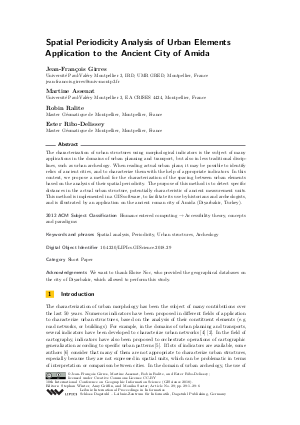Spatial Periodicity Analysis of Urban Elements Application to the Ancient City of Amida (Short Paper)
Authors Jean-François Girres, Martine Assenat, Robin Ralite, Ester Ribo-Delissey
-
Part of:
Volume:
10th International Conference on Geographic Information Science (GIScience 2018)
Part of: Series: Leibniz International Proceedings in Informatics (LIPIcs)
Part of: Conference: International Conference on Geographic Information Science (GIScience) - License:
 Creative Commons Attribution 3.0 Unported license
Creative Commons Attribution 3.0 Unported license
- Publication Date: 2018-08-02
File

PDF
LIPIcs.GISCIENCE.2018.29.pdf
- Filesize: 342 kB
- 6 pages
Document Identifiers
Subject Classification
ACM Subject Classification
- Human-centered computing → Accessibility theory, concepts and paradigms
Keywords
- Spatial analysis
- Periodicity
- Urban structures
- Archeology
Metrics
- Access Statistics
-
Total Accesses (updated on a weekly basis)
0PDF Downloads0Metadata Views
Abstract
The characterization of urban structures using morphological indicators is the subject of many applications in the domains of urban planning and transport, but also in less traditional disciplines, such as urban archeology. When reading actual urban plans, it may be possible to identify relics of ancient cities, and to characterize them with the help of appropriate indicators. In this context, we propose a method for the characterization of the spacing between urban elements based on the analysis of their spatial periodicity. The purpose of this method is to detect specific distances in the actual urban structure, potentially characteristic of ancient measurement units. This method is implemented in a GIS software, to facilitate its use by historians and archeologists, and is illustrated by an application on the ancient roman city of Amida (Diyarbakir, Turkey).
Cite As Get BibTex
Jean-François Girres, Martine Assenat, Robin Ralite, and Ester Ribo-Delissey. Spatial Periodicity Analysis of Urban Elements Application to the Ancient City of Amida (Short Paper). In 10th International Conference on Geographic Information Science (GIScience 2018). Leibniz International Proceedings in Informatics (LIPIcs), Volume 114, pp. 29:1-29:6, Schloss Dagstuhl – Leibniz-Zentrum für Informatik (2018)
https://doi.org/10.4230/LIPIcs.GISCIENCE.2018.29
BibTex
@InProceedings{girres_et_al:LIPIcs.GISCIENCE.2018.29,
author = {Girres, Jean-Fran\c{c}ois and Assenat, Martine and Ralite, Robin and Ribo-Delissey, Ester},
title = {{Spatial Periodicity Analysis of Urban Elements Application to the Ancient City of Amida}},
booktitle = {10th International Conference on Geographic Information Science (GIScience 2018)},
pages = {29:1--29:6},
series = {Leibniz International Proceedings in Informatics (LIPIcs)},
ISBN = {978-3-95977-083-5},
ISSN = {1868-8969},
year = {2018},
volume = {114},
editor = {Winter, Stephan and Griffin, Amy and Sester, Monika},
publisher = {Schloss Dagstuhl -- Leibniz-Zentrum f{\"u}r Informatik},
address = {Dagstuhl, Germany},
URL = {https://drops.dagstuhl.de/entities/document/10.4230/LIPIcs.GISCIENCE.2018.29},
URN = {urn:nbn:de:0030-drops-93577},
doi = {10.4230/LIPIcs.GISCIENCE.2018.29},
annote = {Keywords: Spatial analysis, Periodicity, Urban structures, Archeology}
}
Author Details
References
-
M. Assénat and A. Pérez. Amida 4. Constance et Amida. Anatolia Antiqua, 23:199-217, 07 2014.

-
A. Cliff, P. Haggett, J. Ord, K. Bassett, and R. Davies. Elements of spatial structure : a quantitative approach. Cambridge [Eng.] ; New York : Cambridge University Press, 1975.

-
C. Duchêne, S. Bard, X. Barillot, A. Ruas, J. Trévisan, and F. Holzapfel. Quantitative and qualitative description of building orientation. In 6th ICA Workshop on Generalisation and Multiple Representation, 28-30 April, Paris (France), 04 2003.

-
K. J. Kansky. Structure of Transportation Networks: Relationships Between Network Geometry and Regional Characteristics, volume 84. University of Chicago. Department of Geography. Research papers., 07 1967.

- A. Ruas. A method for building displacement in automated map generalisation. International Journal of Geographical Information Science, 12(8):789-803, 1998. URL: http://dx.doi.org/10.1080/136588198241509.
-
D. Smith. Patterns in human geography. An introduction to numerical methods. David and Charles Newton Abbot, 1975.

